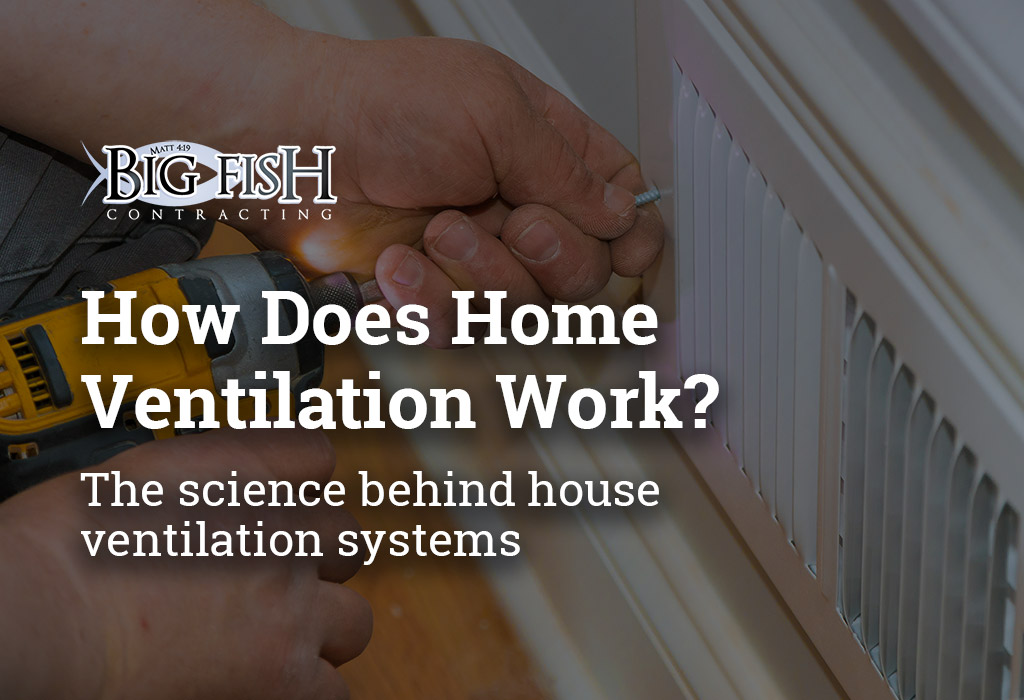The science behind house ventilation systems
Home ventilation—we all know that we need it, especially during the dead heat of summer or bitter cold of winter. But what is it? Why is it so important? And how does it work?
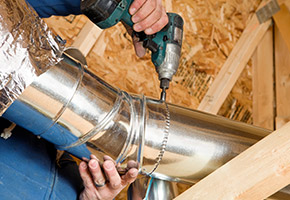
What is home ventilation?
Home ventilation refers to the cycle of old air being expelled from your home while being replaced with new, fresh air. A functional ventilation system allows your home to breathe, which helps regulate indoor temperatures, protects the health and safety of your family, and extends the lifespan of your home.
Why is home ventilation important?
To find out why proper home ventilation is so important we need to look at what can happen with a poor or non-functional ventilation system. A bad ventilation system:
- …Seals in the harmful pollutants (such as carbon monoxide, etc.) caused by gases produced by appliances, which drastically reduces indoor air quality.
- …Traps in moisture which can cause serious damage like mold/mildew and rot build up, structural warping, and damage to insulation and structural materials.
- …Drives up utility bills as the trapped heat and humidity will force your air conditioner to run more than needed, increasing your energy bill. Not to mention the additional maintenance charges from damages incurred from excess moisture.
In short, ventilation is primarily about regulating temperature, filtering pollutants, and controlling moisture. A home without proper ventilation can have serious health and safety implications and can come with major unseen damages—both which decrease the home’s value and drive up its overall maintenance costs.
Proper ventilation is also crucial in prolonging the life of a home by helping to preserve materials like the wood that makes up framing and sheathing and the shingles that make up the roof. Proper roof ventilation prevents warping and buckling of roof framing and premature deterioration of shingles.
Is ventilation still important in the winter? Yes! A roof can (and will) encounter plenty of problems with ice and snow, so your ventilation system needs to be on point to lower your heating bill and stop the heated air from condensing and causing moisture problems in your home (and introducing mold and mildew).
How does home ventilation work?
When hot, humid air meets a cold surface or area, the air will condense and form water droplets. If hot, humid air cannot properly circulate out of your home, condensation will build up in your attic, on your ceilings, or in your roof, causing major damage.
A ventilation system allows your home to breathe and cycle out old, dirty, moisture-filled air for new, fresh air through the use of intake vents and exhaust vents, which work in conjunction with one another. Insulation is another important component to a properly functioning as it helps to keep conditioned air in the living space of a home.
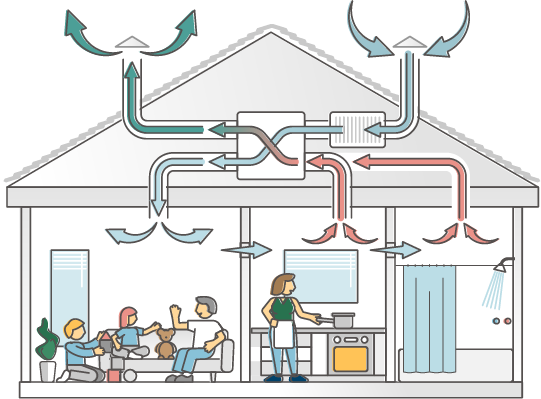
How this works:
- Unventilated air in your home builds up pollutants, moisture, etc. as you and your family eat food, breathe in oxygen, and create waste carried in the air.
- Fresh, unpolluted air enters your home through the intake vents placed at the low points of your roof.
- Air expands and rises as it becomes warmer, so the hot, moisture-filled air rises and escapes through the exhaust vents placed at the height of the roof.
(Note: It is important to have an equal balance of air taken in and air exhausted out for the ventilation cycle to be effective.)
Types of Ventilation Systems
Different types of home ventilation systems work better for different homes based on the owner’s needs and the style of the home.
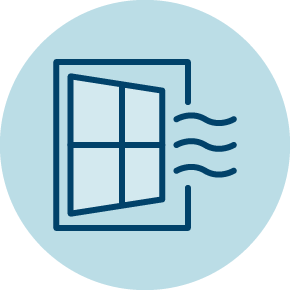
Natural ventilation
Historically, when houses were first being built, this was the most common form of ventilation. Natural ventilation involves naturally occurring, unforced air movement channels (i.e. opening a door or cracking a window) that replace old, unventilated air with fresh air.
While this method can occasionally be helpful, it typically doesn’t allow enough control over the air ventilation or moisture levels in your home and isn’t energy efficient as it can let out the already conditioned or heated air on a particularly hot summer day or cold winter night.

Spot ventilation
Spot ventilation is used for particular problem areas to drive air movement with localized exhaust fans. Examples include bathroom fans or exhaust fans placed over stovetops. While this is helpful in specific instances, spot ventilation methods also force unfiltered air into your home, bringing in environmental pollutants or humidity with it.
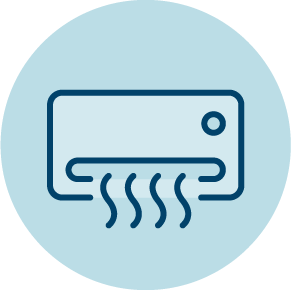
Whole-house ventilation
Whole-house ventilation has quickly become the most popular option for ventilation because it offers more control over the air flow of your home. When in use, whole-house ventilation keeps air continuously moving through a system of multiple fans, vents, and ducts.
Because whole-house ventilation systems get rid of old, indoor air and take in fresh, outdoor air in roughly equal amounts, this system is the best for stabilizing air pressure in the house.
To learn more about the different types of vents used (soffit vents, gable vents, power vents, wind turbines, box vents, ridge vents, etc.), read our blog post about different vent types and which one is best for you.
Home ventilation is essential because stagnant air that remains indoors can build up moisture, odor, dust, carbon monoxide and other pollutants—none of which you want in your home.
An effective ventilation system should:
- Control air leaks
- Allow fresh air into your home
- Ventilate indoor moisture
- Have a moisture escape path
- Hold a consistent temperature in your home
If your ventilation system is failing to do any of the above, contact a local, reputable contractor. They can calculate factors such as your roof size and design, airflow, climate, and cost to determine the correct number of vents and the best type for your home. Every roof is different, so it’s important to find the right ventilation system for you.
Big Fish has over two decades of experience installing and maintaining quality roofing ventilation systems. Call 262-470-1114 or email office@bigfishcontracting.com for an expert opinion and a free estimate.

